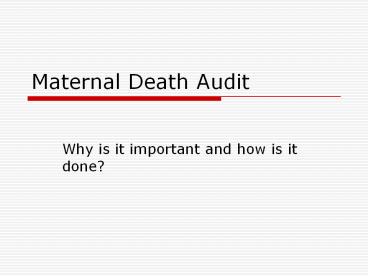Maternal Death Audit PowerPoint PPT Presentation
1 / 19
Title: Maternal Death Audit
1
Maternal Death Audit
- Why is it important and how is it done?
2
Background
- It is critical to determine the levels and causes
of maternal mortality - This will tell us the public health importance of
specific maternal health problems - We can then design appropriate interventions to
reduce maternal mortality
3
Background
- For example, a large number of maternal deaths
due to hemorrhage will point to the need for - Early management of bleeding
- Timely referral
- Access to emergency transport
4
Background
- Or, high levels of maternal death due to
puerperal sepsis, for example, may indicate the
need for - Improved management during delivery
- Improved management after delivery
5
Method
- Maternal Death Audit
- What is Maternal Death Audit?
- Step 1 Examine case records and interview staff
- Step 2 Interview the household of the deceased
person - Step 3 Use this information to reconstruct the
circumstances leading to the death - Step 4 Assign a Cause of Death
6
Step 1 Examine case records and interview staff
- Visit the health premises where she was treated
to examine case records and interview staff - Take note of the recorded obstetric history
- Ask staff about any special circumstances
regarding the death
7
Step 2 Interview the household of the deceased
person
- Meet the relatives of the deceased to collect
information on - the location of the death
- the economic, social and educational profile of
the family - the deceaseds obstetric history and record of
antenatal, delivery and postnatal care, referral
and - the circumstances of death
8
Step 3 Reconstruct the circumstances of the death
- Obstetrician to analyze the direct and indirect
obstetrical causes which led to death - Other team members to examine non-medical causes
of death antenatal care, risk factors,
complications, delay in referral or in initiation
of treatment, non-availability of specialists,
equipment, blood, etc. - Highlight system failures
9
Step 4 Assign a Cause of Death
- Use all the information to assign, as a team, the
primary cause of death - Ask yourselves - Was it preventable?
- Ask yourselves Was it because of a systems
failure?
10
The Process (1)
- Step 1 Report the death to the Deputy Director
of Health Services at the District level - When? Within 24 hours of death
- Who will do it?
- If the death occurs at home, in transit, at the
sub-center ANM to PHC Medical Officer - At the PHC PHC Medical Officer
- Public Hospital or Private Hospital Respective
hospital authorities
11
The Process (1) contd
- Report deaths of all pregnant women, including
due to abortion, suicide, accidents etc.
12
The Process (2)
- Step 2 Form a Maternal Death Investigation Team
at PHC - When? Within 15 days of the death
- Who will be in the team?
- PHC Medical Officer
- Administrator
- 1 Nursing Staff
- BHE
13
The Process (3)
- Place the findings of the team before the
district-level Maternal Deaths Medical Audit
Committee on a monthly basis - Place all reports before the District RCH
Committee chaired by the District Collector,
which receives relatives of the deceased who give
their account of the events - Place the minutes of both meetings before the
Commissioner, HFW
14
The Process (4)
- Provide feedback to relevant FRUs and PHCs
- Provide feedback to relevant personnel involved
in the case - Conduct annual analysis of maternal deaths to
understand causes of death and formulate
appropriate response
15
Analysis What does the Maternal Death Audit
tell you? (TN example)
16
Analysis What does the Maternal Death Audit
tell you?
- Poor distribution of first referral units (FRUs)
- Unnecessary referrals
- Poor quality of care
- Delay in accessing emergency transport
- Obstetric first aid not provided before referral
- etc
17
Analysis Possible Solutions
- Making FRUs functional by contracting in
additional staff - Ensuring emergency transport either by using
untied funds to establish a tie-up with local
transport facility or by setting up an ambulance
facility
18
Analysis Possible Solutions
- Establishing blood storage facilities at the PHCs
- Providing additional training to PHC staff in
emergency obstetric care - Ensuring that all staff are aware of Emergency
Obstetric Care protocols
19
Follow-up
- Medical Officer and Administrator to place the
findings of the Audit before the Arogya Raksha
Samithi (ARS) - ARS to present the findings to the next Gram
Sabha in the presence of the Medical Officer and
Administrator - ARS to facilitate the process of PHC staff and
community taking ownership of the findings of the
Audit

